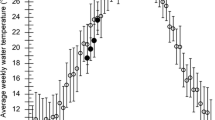Abstract
Four 96-h in situ bioassays were conducted on or near the striped bass spawning grounds in the Delaware River within the States of Delaware, New Jersey and Pennsylvania, USA during 1989 to determine if water quality was sufficient to support larval survival. Tests were accomplished by holding 500 striped bass yolk-sac larvae in each of two 75 L chambers at four locations in the river ranging from north of Philadelphia, PA to Salem, NJ and at one location in the Chesapeake and Delaware Canal. Survival varied significantly among stations; highest survival was in the Chesapeake and Delaware Canal, where it averaged more than 50%. Lowest survival occurred at the station near Salem, NJ, approximately 30 km downriver of the primary spawning grounds, where less than 1% of the larvae survived in any of the tests. Survival at stations closest to the primary spawning grounds was weather-dependent; survival was over 47% during periods of little rainfall, but only 11% following periods of higher than average rainfall.
Similar content being viewed by others
References
Albert RC (1988) The historical context of water quality management for the Delaware estuary. Estuaries 11:99–107
Baker JP (1982) Effects on fish of metals associated with acidification. In: RE Johnson (ed) Acid rain fisheries. American Fisheries Society, Bethesda, MD
Booth CE, McDonald DG, Simons BP, Wood CM (1988) Effects of aluminum and low pH on net ion fluxes and ion balance in the brook trout (Salvelinus fontinalis). Can J Fish Aquatic Sci 45:1563–1574.
Brezina ER (1988) Water quality issues in the Delaware River Basin. In: Majumdar SK, Miller EW, Sage LE (eds) Ecology and restoration of the Delaware River basin. PA Acad Sci, 431 pp
Chittenden ME (1971) Status of the striped bass Morone saxatilis in the Delaware River. Ches Sci 12:131–136
— (1974) Trends in the abundance of American shad, Alosa sapidissima, in the Delaware River Basin. Ches Sci 15:96–103.
Cronan CS, Schofield CL (1979) Aluminum leaching response to acid precipitation: effects on high-elevation watersheds in the northeast. Science 204:304–305
Davis WD (1973) Rates of temperature acclimation for hatchery reared striped bass fry and fingerlings. Prog Fish Cult 35:214–217
Dey WP (1981) Mortality and growth of young-of-year striped bass in the Hudson River estuary. Trans Am Fish Soc 110:151–157
Doroshev SI (1970) Biological features of the eggs, larvae and young of the striped bass Roccus saxatilis (Walbaum) in connection with problems of its acclimatization in the USSR. J Ichthyol 10:235–248
Finger S, Livingstone AC, and Olson SJ (in press) Influence of contamination on survival of striped bass in Chesapeake Bay tributaries. In: Second US/USSR Symposium. Rearing, Reproduction, and Management of Anadromous Fish. Seattle, WA
Hall LW (1987) Acidification effects on larval striped bass, Morone saxatilis in Chesapeake Bay tributaries: A review. Water Air Soil Pollut 35:87–96
— (1988) Studies of striped bass in three Chesapeake Bay spawning habitats. Mar Pollut Bull 19:478–487
Hall LW, Pinkney AE, Horseman LO (1985) Mortality of striped bass larvae in relation to contaminants and water quality in a Chesapeake Bay tributary. Trans Am Fish Soc 114:861–868
Hall LW, Pinkney AE, Herman RL, Finger SE (1987a) Survival of striped bass larvae and yearling in relation to contaminants and water quality in the upper Chesapeake Bay. Arch Environ Contam Toxicol 16:391–400
Hall LW, Hall HS, Bushong SJ, Herman RL (1987b) In situ striped bass (Morone saxatilis) contaminant and water quality studies in the Potomac River. Aquatic Toxicol 10:73–99
Hall LW, Ziggenfuss MC, Bushong SJ, Sullivan JA, Unger MA (1991) Striped bass contaminant and water quality studies in the Potomac River and upper Chesapeake Bay in 1989: Annual contamination and water quality evaluation in east coast striped bass habitats. US Fish and Wildlife Service, Leetown WVA, pp 84
Maurice KR, Blye RW, Harmon PL (1987) Increased spawning by American shad coincident with improved dissolved oxygen in the tidal Delaware River. In: Proceedings of the International Symposium on Common Strategies of Anadromous and Catadromous Fish. American Fisheries Society, Bethesda, MD, pp 79–88
Mehrle PM, Buckler D, Finger S, Ludke L (1984) Impact of contaminants on striped bass: Interim Report. U.S. Fish and Wildlife Service, Columbia National Fisheries Service Laboratory, Columbia, MO
Morgan RP, Rasin VJ, Copp RL (1981) Effects of salinity and temperature on the development of striped bass eggs and larvae. Trans Am Fish Soc 110:95–99
Morgan RP, Rasin VJ, Nol LA (1983) Sediment effects on eggs and larvae of striped bass and white perch. Trans Am Fish Soc 112:220–224
Palawski D, Hunn JB, Dwyer FJ (1985) Sensitivity of young striped bass to organic and inorganic contaminants in fresh and saline waters. Trans Am Fish Soc 114:748–753
Schofield C, Trojnar J (1980) Aluminum toxicity to brook trout, Salvelinus fontinalis in acidified waters. In: Toubarn T, Miller M (eds) Polluted rain. Plenum Press, NY, pp 341–365
Sharp JH, Culberson CH, and Church TM (1983) The chemistry of the Delaware estuary: General considerations. Limnol Oceanogr 27:1015–1028
Weisberg SB, Burton WH (in press) Spring distribution and abundance of ichthyoplankton in the tidal Delaware River. Fish Bull
Author information
Authors and Affiliations
Rights and permissions
About this article
Cite this article
Burton, W.H., Weisberg, S.B., Brindley, A. et al. Early life stage survival of striped bass in the Delaware River, USA. Arch. Environ. Contam. Toxicol. 23, 333–338 (1992). https://doi.org/10.1007/BF00216242
Received:
Revised:
Issue Date:
DOI: https://doi.org/10.1007/BF00216242




